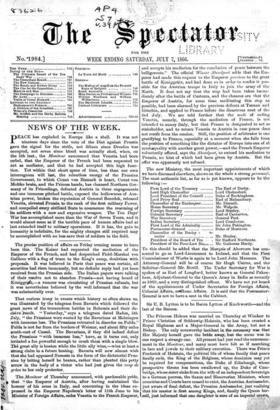The new Ministry, the most important appointments of which we
have discussed elsewhere, shows on the whole a strong personnel- The most authentic list, as far as is yet known, appears to be the following ;- First Lord of the Treasury The Earl of Derby.
Lord High Chancellor Lord Chelmsford.
Lord President of the Council Duke of Buckingham.
Lord Privy Seal Earl of Malmesbury.
Chancellor of the Exchequer Mr. Disraeli.
Home Secretary Mr. Walpole.
Foreign Secretary Lord Stanley.
Colonial Secretary Earl of Carnarvon.
War Secretary General Peel.
Indian Secretary Lord Cranborne.
First Lord of the Admiralty Sir John Pakington.
Postmaster-General Duke of Montrose.
Chancellor of the Duchy f n-
caster Mr. Henley.
President of the Board of Tra • Sir Stafford Northeote.
President of the Poor-Law Boa...- Mr. Gathorne Hardy.
To this should be added that the Marquis of Abercorn has con- sented to go as Lord-Lieutenant to Ireland, and that the First Commissioner of Works is again to be Lord John Manners. The Attorney-General will be of course Sir Hugh Cairns, and the Solicitor-General Mr. Bovill. The Under Secretary for War is spoken of as Earl of Longford, better known as General Paken- ham, Adjutant-General to the Queen's Army in India as recently as 1860, and a very distinguished officer. We have not yet heard of the appOintments of Under Secretaries for Foreign Affairs, Colonial Affairs, °idiom° Affairs. It is said that the Postmaster- General is not to have a seat in the Cabinet.






























